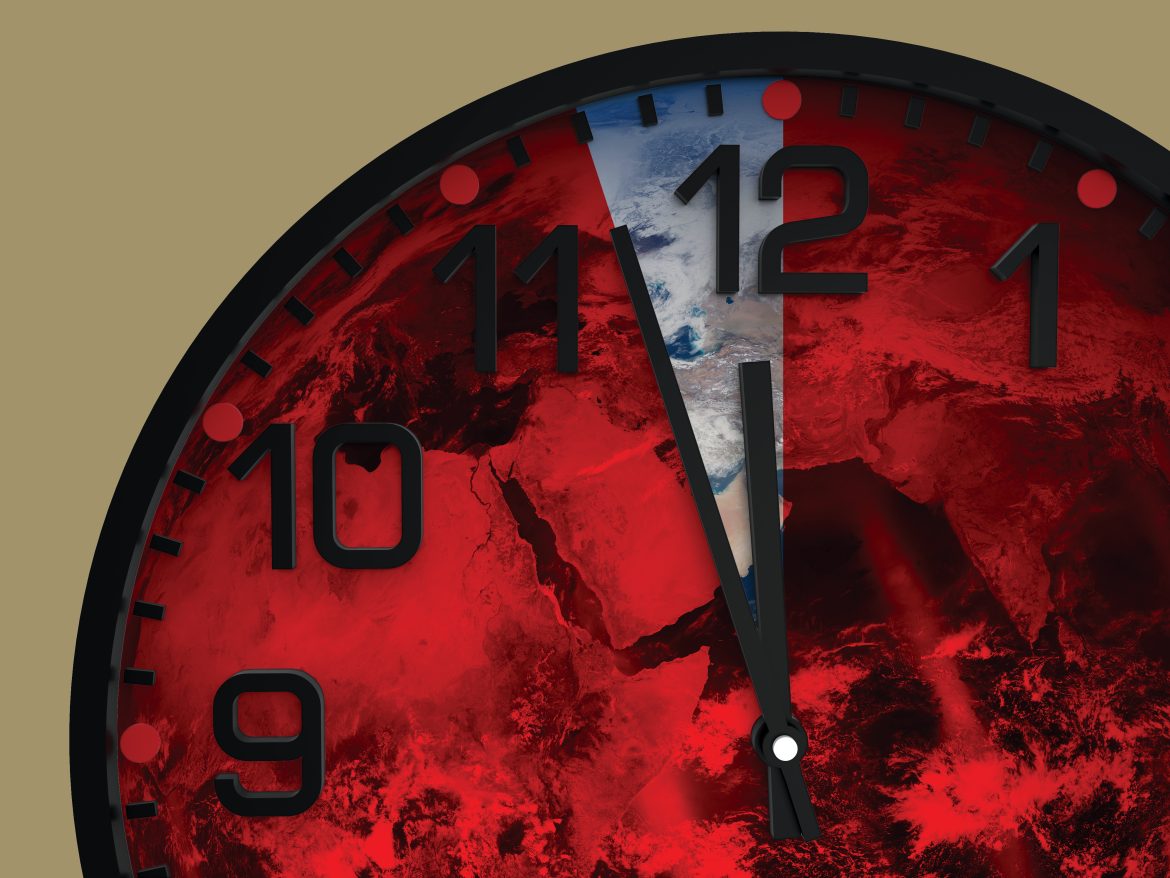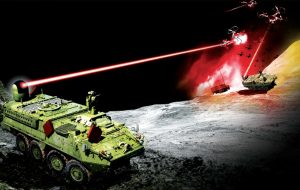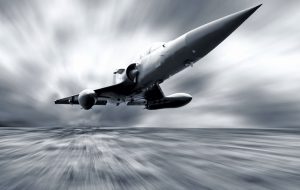The Doomsday Clock is a design meant to warn us about how close we are to destroying our world, with midnight being the theoretical point of that end.
On January 24, 2023, the Science and Security Council, a non-profit organization based in Chicago, USA, in coordination with the Council of Shepherds, which includes 10 Nobel laureates, announced through the Bulletin of the Atomic Scientists that during this year’s reset, the Doomsday clock will move to 90 seconds before midnight, which is a 10 seconds leap forward.
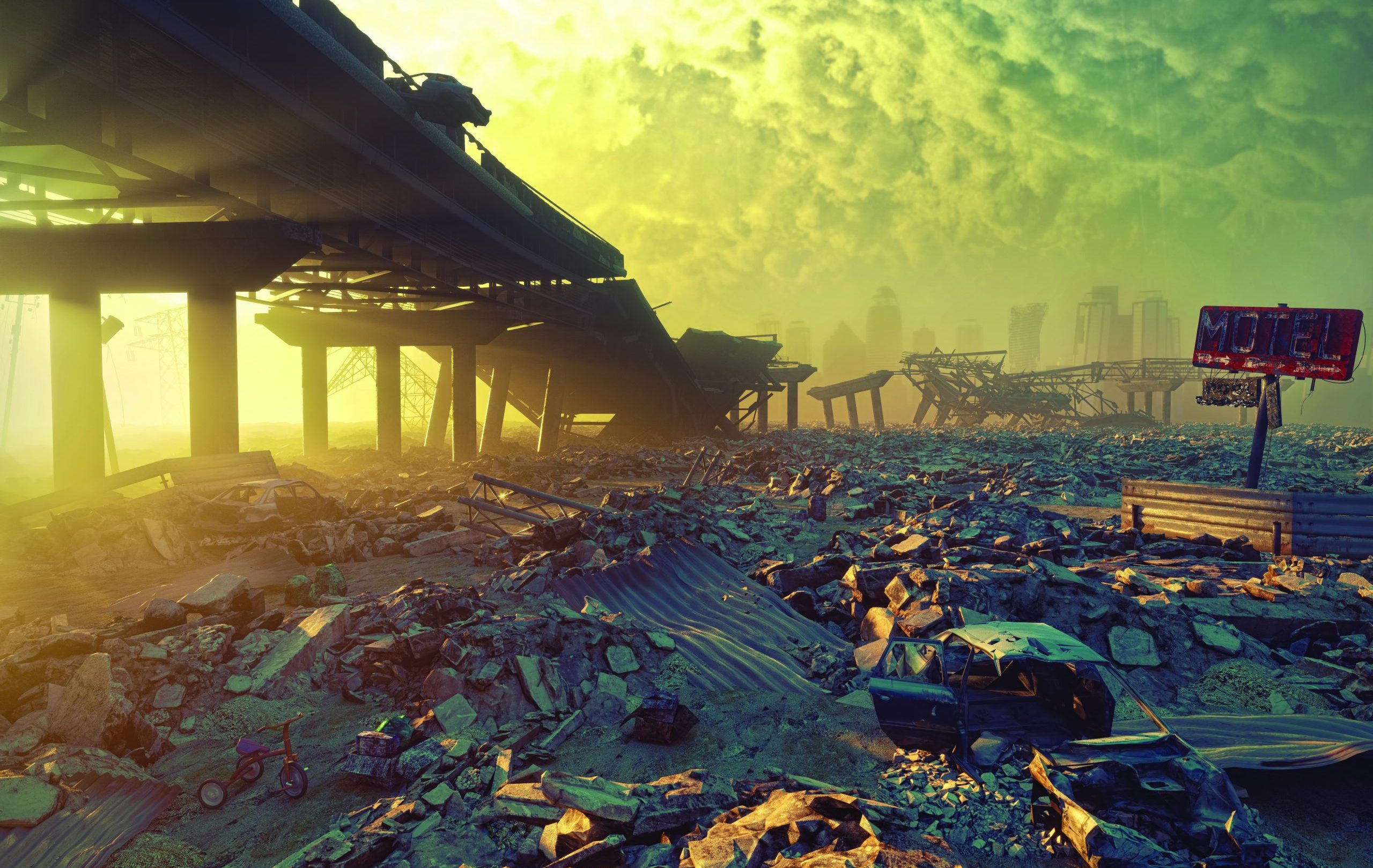
This move comes in light of the war in Ukraine that broke out on February 24, 2022, biological threats, the spread of nuclear weapons, and the return of the arms race based on quality rather than quantity, which includes military artificial intelligence programs, the continuation of the climate crisis and the resulting carbon emissions, the rise in global temperatures, the increase in desertification, hurricanes, floods, problems in food and energy security, and the spread of epidemics and diseases, in addition to earthquakes, fires, droughts, and other natural disasters.
The Council suggested that the 5 permanent members of the UN Security Council take the initiative by adopting new commitments to confronting nuclear threats, through the implementation of more arms control and strategic stability agreements and instead of spending money on armaments and wars, they can be directed towards achieving development, prosperity and global cooperation in the face of threats to life on the planet, which will turn back the clock.
This is the 25th move of the Doomsday Clock, as members of the Science and Security Council annually reset it to reflect whether the events of the passing year have pushed humanity closer to destruction, or away from it, by relying on a database of more than 100 predictions to assess the risks.
The Doomsday Clock predicts how close humanity has become to total annihilation, based on indicators developed by a number of the world’s most prominent science and security experts about the nuclear and climate risks threatening humanity’s existence, making it a symbolic tool for showing how close humanity is to self-destruction and calling for action to turn the clock back.
This clock evaluates the world’s ability to face risks, as the time needed to implement a decision to use nuclear weapons ranges between 5 and 10 minutes only.
These few minutes are what separate the world from “Doomsday”, which is the sufficient period to make a decision, and press a button to launch a nuclear attack that leads to the annihilation of life on earth.
Studies indicate that each nuclear weapon in the United States or Russia is capable of causing 40 times the destruction made by the Hiroshima bomb, meaning that 50 nuclear bombs can kill at least 200 million people.
On February 6, 2023, the Secretary-General of the United Nations said in his opening speech to the General Assembly: “Experts are studying how close humanity is to self-destruction, and at the beginning of 2023, they studied the state of the world in light of the Russian invasion of Ukraine, the disasters of climate change, and the escalation of nuclear threats, which led them to the conclusion that the Doomsday clock is only 90 seconds away from midnight.
This is the closest the hands of the clock have got ever, which is closer than the cold war era, thus it represents a global warning so we must pay attention and start turning the clock backwards.
The Secretary-General of the United Nations expressed his fears about the expansion of the war in Ukraine, warning that the world faces the highest risk of starting a nuclear war, deliberately or by mistake and stated, “I fear that the world is unconsciously approaching a wider war, I’m afraid it is doing so with its eyes wide open. The world needs peace, and the so-called tactical use of nuclear weapons is absurd.”
For his part, the Kremlin spokesman announced that the global situation is alarming, blaming the United States and NATO for their role in the war in Ukraine and warned that the world is facing the threat of a third world war and called on the leaders of the United States and Germany to stop the ticking nuclear clock, in an apparent reference to the intention of the two countries and other Western countries to send main battle tanks to Ukraine.
Moreover, the former Russian president and deputy secretary of the Russian Security Council, Medvedev, said in a statement reported by the Russian “TASS” news agency: “Unfortunately, once the third world war breaks out, it will not be about tanks or even fighter planes, as everything will certainly turn to dust”.
Answering a question about how to set this clock back a little, Medvedev said: “Let the watchmakers stop the ticking of the nuclear clock for a while”.

For its part, the United States believes that appealing to Russia’s allies is vital to warn it against the use of nuclear weapons, which is what German Chancellor Olaf Scholz did during his visit to Beijing in November 2022, and his meeting with the Chinese president, as Olaf announced in a joint statement that nuclear weapons should not be used in the Russian-Ukrainian war.
In this context, a year after the conflict in Ukraine erupted, China used a 12-point document, titled “China’s Position on the Political Settlement of the Ukrainian Crisis”, published on February 24, 2023, to call on Russia and Ukraine to resume talks and expressed its rejection of the use of nuclear weapons.
The document stated, “Nuclear weapons should not be used and a nuclear warfare should not be fought, and the threat of nuclear weapons should be rejected”.
Commenting on this document, the Secretary-General of NATO accused Beijing of siding with Moscow, with which it concluded a strategic alliance treaty, noting that China did not condemn the Russian invasion of Ukraine.
Furthermore, US President Joe Biden rejected the Chinese “peace plan”, and said that “its implementation will only benefit Russia”.
China has always affirmed that it will continue to pursue a defensive nuclear strategy and will not be the one to start using nuclear weapons, whatever the circumstances, and that its nuclear arsenal will continue to be at the minimum necessary to protect its national security, as part of the framework of its commitment to peaceful development and its defensive military policy.
On March 3, 2023, the statement of the foreign ministers of the “Quad” (the United States, Japan, India and Australia) condemned the Russian threat to use nuclear weapons in the Ukraine war, describing it as unacceptable, and stressed in a joint statement the importance of respecting international law in the East and South China Seas, in the face of challenges facing the rules-based maritime order.
However, the failure of global governance was clearly demonstrated when divisions dominated the G20 foreign ministers’ meeting – which includes the major industrialized and developing countries in the world, including Russia and China – in New Delhi, on the 1st and 2nd of March 2023, as a result of a divergence in visions between the international powers on various files, foremost of which is the Ukrainian war, as China joined Russia in refusing the support demand for Moscow to stop hostilities in Ukraine.
Senior diplomats at the meeting discussed issues of food security, energy, cooperation for sustainable development, counter-terrorism, new and emerging threats, disaster relief operations, and the repercussions of the Ukraine crisis for other countries.
In his speech to the meeting, the Indian Prime Minister stated that multilateral institutions have failed to face the most pressing challenges in the world in the past few years, as demonstrated by wars, the financial crisis, the covid-19 pandemic, climate change and the war on terrorism.
Furthermore, 2022 was a record year for North Korean missile tests, where around 30 cruise and ballistic missiles were tested, which indicates the failure of the international sanctions imposed on this country, which led to a new variable in the Japanese national security strategy, which is the allocation of a historic budget –for the first time – for the Japanese Self-Defense Forces worth $315 billion over five years.
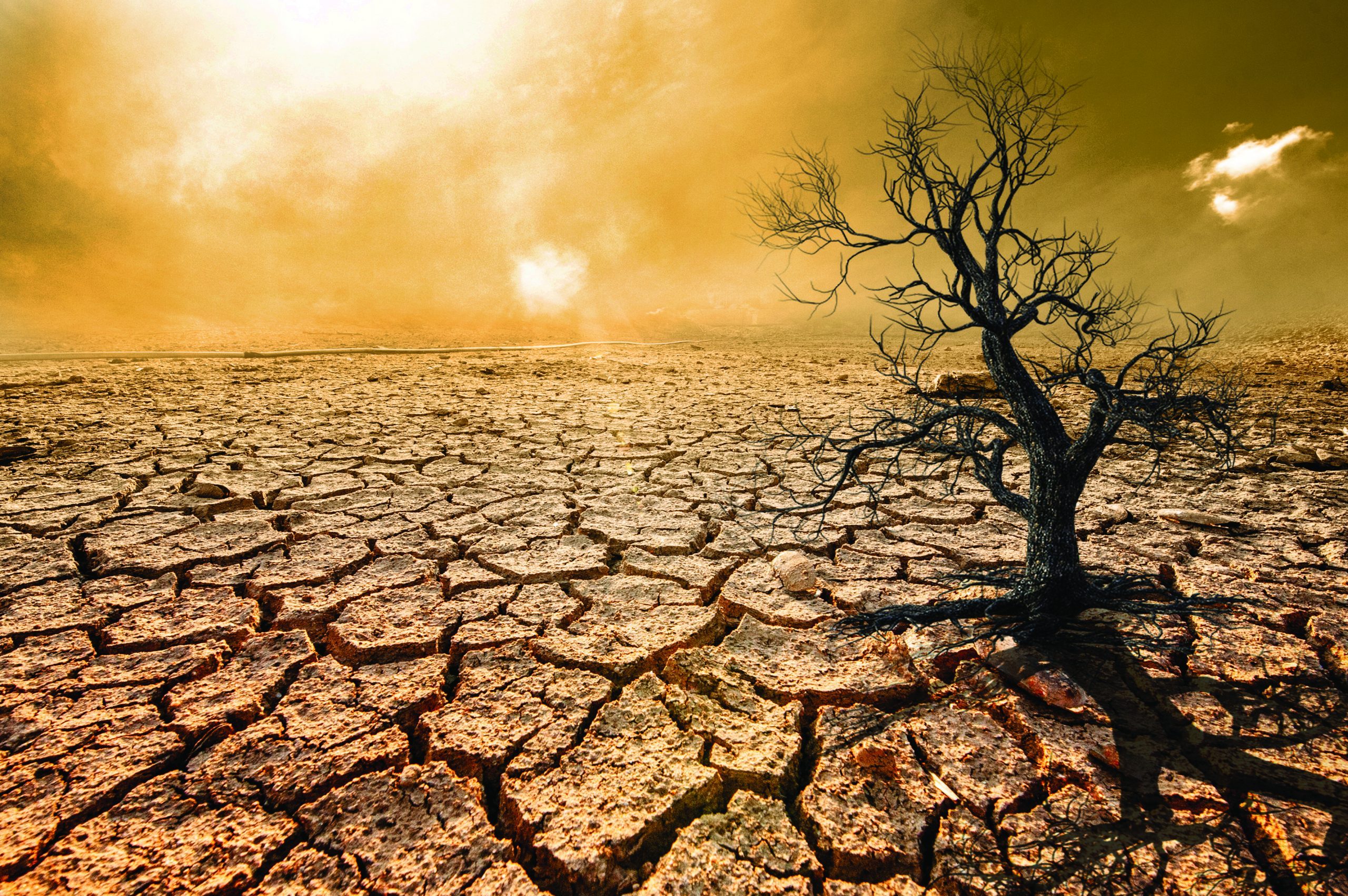
The Clock’s design and movement
In 1945, Albert Einstein, and other scientists who worked on the Manhattan Project to produce the American nuclear bomb during World War II, founded the Bulletin of the Atomic Scientists, followed by the Science and Security Council, with its first president being Robert Oppenheimer, dubbed the “Father of the Nuclear Bomb”.
The Bulletin first unveiled the Doomsday Clock at the start of the Cold War era in 1947, and only 4 months after the atomic bomb was dropped on Hiroshima, the first issue of the bulletin was issued, which, after two years, turned from a printed newsletter into a magazine and on its cover was the design of the first doomsday clock with its hands standing at seven minutes before midnight.
After the former Soviet Union conducted its first nuclear test in 1949, the clock was moved forward from 7 to 3 minutes before midnight.
Upon the detonation of the first hydrogen bombs in Washington and Moscow in 1953, the clock was moved to 2 minutes before midnight, the closest it had ever been to the point of catastrophe.
In 1988, the clock was set at 6 minutes before midnight, after the United States and the former Soviet Union signed a treaty in Washington to eliminate medium-range nuclear weapons, which went into effect on June 1, 1988, the improved relations between the two countries, and the opposition of more countries for nuclear weapons.
Pointing to 17 minutes before midnight, the clock was farthest away from doomsday in 1991, as the Cold War had ended, and Moscow and Washington signed the Strategic Arms Reduction Treaty, known as “START”, which prompted the bilateral reduction of nuclear weapons.
In 1995, the clock was set to 14 minutes before midnight because of further reductions in weapons arsenals, despite the continued global military spending at its rates, and the growing fears of nuclear leakage from former nuclear facilities, which lacked the proper safety and security measures.
The Doomsday clock advanced from 9 to 7 minutes before midnight in 2002, due to the United States’ withdrawal from the Ballistic Missile Treaty, fears of the spread of nuclear and biological weapons, and the efforts made by some groups to obtain these weapons.
In January 2012, the clock was set to 5 minutes before midnight due to the lack of seriousness in the fight against nuclear weapons, global conflicts, and climate change.
In 2017, the clock moved forward again to 2 and a half minutes before midnight, due to the victory of US President Donald Trump in the US elections and then moved forward 30 seconds in January 2018 due to North Korea’s nuclear threats and the increased threat of global warming.
The clock was moved forward to 100 seconds before midnight in January 2021, which is the closest it has ever gotten to midnight in history and it remained at this time in 2022.
Doomsday Clock & the New START Treaty
The most important question here is: How will the clock move after the recent developments regarding the New START treaty? On February 24, 2023, Russia announced that it is suspending its participation in the Strategic Arms Reduction Treaty, known as the “New START”, which is the last arms control treaty between Moscow and Washington – together the US and Russia own about 90 % of nuclear warheads in the world- aimed at disarming nuclear weapons.
Putin reminded the world of the size and strength of Moscow’s arsenal by saying that he is ready to use all necessary means to defend the territorial integrity of Russia and Moscow warned that the West’s determination to defeat it might prevent the renewal of the treaty when it expires in 2026.
However, it announced that it would continue to respect the limits on the number of strategic offensive weapons stipulated in the treaty, despite its decision to suspend participation.
In his State of the Nation Address, Putin said: “Russia should stand ready to resume nuclear weapons tests if the United States does.” This means ending the ban on nuclear weapons tests, which was imposed on September 10, 1996, by the Nuclear Test Ban Treaty, which prohibited any detonation of nuclear bombs, even for peaceful purposes.
Furthermore, Putin accused Washington and its allies in NATO of wanting to defeat Russia, saying: “They want to inflict a strategic defeat on us and at the same time access our nuclear facilities, therefore I’m obligated to announce that Russia will suspend its participation in the treaty”.
Putin added: “While the US presses for the resumption of inspections of Russian nuclear facilities under the agreement, NATO allies helped Ukraine launch drone attacks on Russian air bases where strategic nuclear bombers are stationed, and these drones were equipped and modernized with the help of NATO experts”.
The United States responded by stating that it would remain ready to discuss strategic arms control at any time with Russia, regardless of anything happening in the world.
The US President, Joe Biden, said that he did not interpret the Russian president’s decision to temporarily suspend participation in the “New START” treaty as an indication that he is thinking about using these weapons.
The “New START” treaty was signed between Moscow and Washington on April 8, 2010, in the Czech capital, Prague, by both the former Russian president, Dmitry Medvedev, and the former American president Barack Obama, and it went into effect on February 5, 2011.
After much controversy stemming from Washington’s request to include China in the agreement, the two parties agreed in 2021 to extend the agreement for five additional years to February 2026.
In March 2020, the two countries agreed to suspend inspections due to the covid-19 pandemic and Russia announced the suspension of planned inspections at its military sites within the framework of the treaty, in response to obstacles to Russian inspections in the United States, which Washington considered a violation of the terms of the treaty.
The treaty dictates a reduction in the nuclear arsenals of the two countries to a maximum of 1,550 nuclear warheads, and 700 long-range missiles and bombers, while allowing inspectors from both sides to conduct joint inspections of military sites on both sides, to ensure that the terms of the treaty are not violated.
After the strategic arms reduction talks between Moscow and Washington, it was agreed to reduce strategic offensive weapons, and to inspect and verify operations under the “START 1” agreement that was signed on July 31, 1991, which went into effect on December 5, 1994, and prevented the two parties from deploying more than 6,000 nuclear warheads on 1,600 intercontinental ballistic missiles and bombers.
In 2011, the START 2 strategic arms reduction treaty between the United States and Russia entered into effect, after the two sides exchanged ratification documents during a security conference in Munich, Germany.
Replacing the “START 1” treaty, which ended in 2009, The new treaty dictates a reduction in the number of nuclear warheads in the possession of each party to 1,500 nuclear warheads, allowing each party to inspect the nuclear capabilities of the other party to ensure that the number of nuclear warheads carried by each missile is in accordance with the terms of the treaty.
Furthermore, the treaty imposed controls on the number of nuclear warheads and missiles that each party can deploy on land, submarines and bombers.
As the nuclear arms control system is undermined, the ambiguous future of the New START Treaty, and the trend towards strengthening nuclear capabilities, the nuclear threat has been escalating globally and after decades of nuclear disarmament efforts, all nuclear powers today are spending a lot of money on new nuclear warheads and their delivery systems, such as missiles, ships, submarines, and aircraft.
For instance, the US is spending about $10 billion to modernize its nuclear bombs and replace the old tactical nuclear bombs with the new model B61-12, which was developed in the 1960s and tested for the first time after the Cuban missile crisis in 1962.
The modernization program for these bombs was approved during the era of former US president, Barack Obama, and it is run by the US Department of Energy to replace about 100 bombs stored at air bases in some NATO countries.
The program also includes retrofitting non-strategic combat aircraft, such as the F-35, to carry these small bombs.
Furthermore, the US defence budget for 2023 confirmed the modernization of the US nuclear triad, including nuclear submarines, and full funding for the production program of the sixth-generation B-21 Raider strategic bombers, capable of carrying nuclear weapons, as the US Department of Defence intends to order 100 aircraft of this type at a cost of more than $690 million per plane.
Nuclear doomsday weapons
The combined Russian and American nuclear arsenal has enough destructive power to wipe out life on the planet several times over, each side can absorb the first strike and launch a second retaliatory strike that can totally destroy the other side.
The exact numbers of nuclear weapons, and their whereabouts, are generally considered top secret, however, some reports indicate that Washington and Moscow own about 90 % of nuclear weapons in the world.
In total, about 12,700 nuclear bombs exist in the world, Russia has an estimated 6,000 nuclear warheads, about 1,588 of which are deployed and ready for launch while the rest are in storage.
The United States has more than 5,400 nuclear warheads, 1,644 of which are ready for launch and about 3,665 are in storage.
Moreover, as part of its commitment to extend the element of deterrence, the United States has about 100 B61 tactical nuclear bombs on NATO bases in Europe, with some bases having the upgraded model of this B61-12 bomb.
On October 29, 2022, Moscow called on Washington to recall the nuclear weapons it had sent to other countries and eliminate the infrastructure for their storage and maintenance abroad, in addition, it requested that the US abandons the practice of simulating the use of such weapons by non-nuclear states within the framework of the alliance’s joint nuclear missions, which is inconsistent with the fundamental principles of the Treaty on the Non-Proliferation of Nuclear Weapons (NPT), given that in these times of increased tension and risk, nuclear countries have a special responsibility to prevent escalation.
In June 2022, the Stockholm International Peace Research Institute (SIPRI) report revealed that the number of nuclear weapons in the world will rise in the next decade in the 9 nuclear powers – The United States, Russia, the United Kingdom, China, France, India, Israel, North Korea, and Pakistan – due to escalating global tensions, after 35 years of decline.
Meanwhile, tensions in Eastern Europe, the Pacific region and the Korean Peninsula have contributed to the rise of more military alliances and partnerships and an increase in military spending.
Thus, the development of new generations of defence systems has become one of the top items on the agendas of many countries.
Furthermore, Russia seems to want to keep the fear of its huge nuclear arsenal alive in the hearts and minds of the west, which may prevent the direct intervention of NATO countries in the war to help Ukraine.
Recently, in response to the decision of some Western countries to supply tanks to Ukraine, the Russian president said: “We are not sending our tanks to their borders, but we have the means to respond, and everyone needs to understand that it will not end by using armour”.
That’s why Russian officials have often referred to strengthening the “nuclear triad,” which means: land-launched intercontinental ballistic missiles, strategic bomber-launched missiles, and submarine-launched ballistic missiles.
In December 2022, the Russian President announced that his country would raise the combat readiness of its nuclear triad as part of what he described as a policy of maintaining the balance of nuclear deterrence, as a basis for stability in the world, after he warned of the growing danger of a nuclear war in the context of tensions between Russia and the West over the backdrop of the war in Ukraine.
In the past, the Russian president confirmed that Moscow might add to its military doctrine the possibility of launching a preemptive nuclear first strike to disarm its opponent, adding that Russia would continue to strengthen its nuclear forces, with the deployment of intercontinental ballistic missiles of the “Sarmat” model capable of carrying nuclear warheads.
In April 2022, Russia conducted the first successful test on the Sarmat missile, which the Russian Ministry of Defence says “is capable of penetrating all defences, and has no equal in the world.”
In 2018, Moscow unveiled, for the first time, the K-329 Belgorod submarine also known as the “Doomsday submarine”, which is the largest nuclear submarine in the world, with a length of about 182 metres, and featuring great stealth and manoeuvrability.
Moreover, Moscow says that the “Poseidon” or Doomsday torpedo, is a new type of strategic nuclear weapon, and some reports indicate that it can move at a speed of more than 200 km / h, at a depth of 1000 metres below the surface of the water, in addition, the long-range torpedo has a nuclear propulsion system and can manoeuvre and change direction and depth, which makes it extremely difficult or even impossible for conventional missiles to intercept it.
Furthermore, the radioactive wave caused by its explosion causes a nuclear radioactive tsunami with 500-metre waves hitting coastal cities.
The nuclear warhead for this torpedo will have a yield of 100 megatons, meaning it will be about 7000 times more powerful than the atomic bomb dropped on Hiroshima in August 1945.
In his Defenders of the Fatherland Day speech, President Putin stressed that “A modern and effective army and fleet ensures the country’s security and sovereignty and guarantees its stable development and future, therefore, we will prioritize strengthening our defence capability”.
Putin announced that the first platforms of the “Sarmat” missile system will enter service in 2023, which will also see the delivery of large quantities of the hypersonic 3M22 “Zircon” naval missiles, adding that Moscow will continue to produce the Kh-47M2 “Kinjal” -Russian for dagger – hypersonic missile, which is an air-to-surface missile manufactured to arm the modernized MiG-31K long-range fighter/interceptor.
According to the Russian army, the Kh-47M2 “Kinjal can hit targets at a distance of 2,000 km, at a speed of up to 10 Mach, which makes intercepting it with any missile defence system extremely difficult.
The Russian army unveiled the missile on March 1, 2018, along with 6 other strategic weapons, and according to Russia, it can perform manoeuvres during each phase of its flight and carry a conventional or nuclear warhead.
How is the EU preparing for Doomsday?
In preparation for Doomsday, the European Union approved a program called the “Rescue Program” a month after the Ukrainian war erupted.
This program sets contingency plans for dealing with major disasters that may affect the countries of the Union, including nuclear attacks, based on a rapid response to any attack with any type of weapon of mass destruction.
Therefore, the EU allocated a budget for providing medical supplies that can be used in these circumstances, preparing specialized teams and equipment and developing plans for minimizing risks.
On the other hand, the European Commission developed an emergency plan involving the provision of shelters to accommodate large numbers of people in record time and set a plan to evacuate them from places of danger, as well as provide mobile hospitals and places to prepare food and drink and heating and cooling devices.
NATO & Doomsday exercises
Dmitry Medvedev, the former Russian president and deputy secretary of the Russian Security Council, noted that “nuclear powers never lose in major conflicts that can decide their fate”, and the Kremlin praised these statements, pointing out that they are fully consistent with Russia’s nuclear doctrine.
Subsequently, on January 20, 2023, the Deputy Secretary-General of NATO announced that the exercises conducted by the nuclear forces of the member states throughout the alliance are necessary to ensure effective nuclear deterrence, which was, and still is, one of the fundamental tenets of the alliance.
on June 29, 2022, the heads of state and government of NATO approved the new strategic concept document for the alliance in Madrid, while the previous version was approved at the NATO summit in Lisbon in 2010.
This new concept defines the alliance’s priorities and its basic tasks for the next decade and clarifies the goals and principles of the alliance, and defines its 3 basic tasks: deterrence and defence, crisis management and prevention, and cooperative security.
NATO’s new Strategic Concept adopts a balanced position on nuclear weapons, recognizing their critical role in deterrence, arms control, disarmament and non-proliferation.
Furthermore, the document states that “As long as nuclear weapons exist, NATO will remain a nuclear alliance, whose goal is a safer world for all, and which seeks to create a security environment for a world free of nuclear weapons”.
Thus, NATO’s new Strategic Concept stresses that the primary goal of NATO’s nuclear capability is to maintain peace, prevent coercion, and deter aggression, indicating that it is highly unlikely that NATO uses nuclear weapons, however, any use of nuclear weapons against the Alliance would fundamentally change the nature of the conflict, in a way that would cost the enemy far more than the benefits it could ever hope to gain by using nuclear weapons.
However, NATO’s nuclear deterrent depends on the proliferation of US nuclear weapons in Europe, and the contributions of the allies involved, as the American strategic nuclear forces are the top guarantee of the security of the alliance, while the independent strategic nuclear forces of Britain and France play a deterrent role of their own, contributing greatly to the security of the alliance.
Furthermore, the Alliance will continue to invest in its defence against chemical, biological, radiological and nuclear threats.
Since the beginning of the Russian-Ukrainian war, NATO made sure not to provide Kyiv with weapons that can reach Russian territory.
On October 13, 2022, the Secretary-General of NATO said that there will be serious consequences if Russia uses nuclear weapons against Ukraine and that NATO is highly unlikely to use nuclear weapons because their primary purpose is deterrence, maintaining peace and deterring aggression.
However, in the second half of October 2022, NATO conducted the “Steadfast Noon” manoeuvers at a military base in northeastern Belgium, to test the readiness of NATO countries for any possible nuclear strike, and to ensure the integrity and effectiveness of the Alliance’s nuclear deterrence.
The international community & risk management
In a report published on February 28, 2023, the International Science Council, a non-governmental organization (NGO) based in Paris and includes dozens of scientific bodies in various fields, called on world governments to rethink how to manage risks and deal with natural disasters and limit their damage, noting that governments often act after a disaster strikes, rather than before.
In 2015, the international community adopted a strategy known as the “Sendai Framework”, which was adopted during the 3rd United Nations World Conference held in the Japanese city of Sendai on March 18, 2015.
This strategy aims to reduce human and material losses by 2030, by investing in monitoring natural threats and disasters, and reducing their effects, as soon as they occur.
The report indicated that since the early 1990s, the world has witnessed more than ten thousand disasters, including volcanic eruptions, earthquakes, storms, droughts, floods, and high temperatures, affecting billions of people around the world.
The report stated that floods and storms, which increased in frequency and severity due to climate change, constitute about 42% of the total disasters in the world, and while the international community rushes to act after disaster strikes, little attention is paid to long-term planning, even though warning of the disasters just 24 hours before they occur reduces human and material losses by up to a third.
On February 2, 2022, the International Energy Agency announced that global energy-related carbon dioxide emissions increased in 2022 by 0.9 %, setting a record, but this rate remains lower than expected due to the increasing use of renewable energy sources.
The agency stated that energy emissions, which account for more than 75% of total greenhouse gases, maintain an unsustainable growth path, which exacerbates the problem of climate change.
Conclusion
The Doomsday Clock moves closer to midnight or farther from it based on scientists’ assessment of existential threats.
The farthest the clock was from midnight was 17 minutes, after the end of the Cold War in 1991.
Threats can arise from political tensions, wars, climate change, and even epidemic diseases, and the clock is reset annually accordingly.
Furthermore, the decrease in the risks of a bilateral or unilateral nuclear war does not necessarily mean that the threat of nuclear weapons has disappeared, given that a nuclear attack can happen by mistake, as errors have occurred in the past and can happen again as a result of the similarity of indicators of certain events and phenomena with indicators of a nuclear attack.
By: Major General Dr Ali Muhammad Ali Rajab (military researcher and strategic expert)


